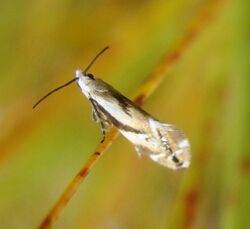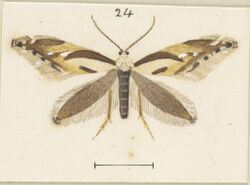Biology:Mnesarchella acuta
| Mnesarchella acuta | |
|---|---|

| |
| Scientific classification | |
| Domain: | Eukaryota |
| Kingdom: | Animalia |
| Phylum: | Arthropoda |
| Class: | Insecta |
| Order: | Lepidoptera |
| Family: | Mnesarchaeidae |
| Genus: | Mnesarchella |
| Species: | M. acuta
|
| Binomial name | |
| Mnesarchella acuta (Philpott, 1929)
| |
| Synonyms[1] | |
| |
Mnesarchella acuta is a species of primitive moths in the family Mnesarchaeidae. It was described by Alfred Philpott in 1929, and is endemic to New Zealand. It is found in the Rangitikei, Wellington, Marlborough Sounds, Nelson, Buller, Westland, Kaikōura and north Canterbury regions. It is very similar in appearance to M. hamadelpha. This species lives in a variety of damp habitats in forests or near waterways that are not exposed to all day sunlight and can be found at altitudes ranging from sea-level up to 900 m. Adults are day flying and are on the wing from October to January.
Taxonomy
Although this species was first collected by Edward Meyrick in 1886 specimens were assumed to be M. hamadelpha.[1] It was not until Alfred Philpott's genitalic studies that this confusion was resolved.[2] M. acuta was therefore first described by Alfred Philpott in 1929 and named Mnesarchaea acuta.[2] In 2019 George William Gibbs reviewed the species within the family Mnesarchaeidae.[1] He placed within the genus Mnesarchella.[1] The presumed type material is held at the New Zealand Arthropod Collection.[1]
Description
Philpott originally described the species as follows:
M. acuta differs from M. hamadelpha in having the thorax white instead of ochreous; also, the basal fuscous streak of the forewing is apically pointed and bent obliquely downwards and has a blunt or suffused apex.[2]
Distribution
This species is endemic to New Zealand.[3][4] This species is found in the Rangitikei, Wellington, Marlborough Sounds, Nelson, Buller, Westland, Kaikōura and north Canterbury regions.[1]
Habitat
This species lives in a variety of damp habitats in forests or near waterways that are not exposed to all day sunlight.[1] This species can be found at altitudes ranging from sea-level up to 900 m.[1]
Behaviour
Adults of this species are on the wing from October to January.[1] It is a day time flying moth with males being frequent fliers but females being sedentary.[1] This moth species is not attracted to light trips.[1]
References
- ↑ 1.00 1.01 1.02 1.03 1.04 1.05 1.06 1.07 1.08 1.09 1.10 , Wikidata Q104802925
- ↑ 2.0 2.1 2.2 , Wikidata Q108243130
- ↑ "Mnesarchella acuta Philpott, 1929". 2021. https://nztcs.org.nz/nztcs-species/44772.
- ↑ Biota of New Zealand (19 September 2023). "Mnesarchella acuta (Philpott, 1929)". https://biotanz.landcareresearch.co.nz/scientific-names/ae935ce0-3a1c-45fe-bf71-b1a6689e7728.
Wikidata ☰ Q108228454 entry
 |


